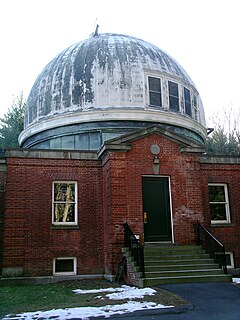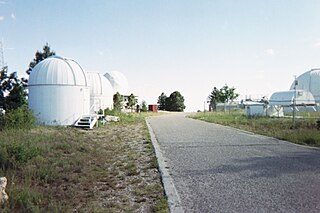
Lowell Observatory is an astronomical observatory in Flagstaff, Arizona, United States. Lowell Observatory was established in 1894, placing it among the oldest observatories in the United States, and was designated a National Historic Landmark in 1965. In 2011, the Observatory was named one of "The World's 100 Most Important Places" by Time Magazine. It was at the Lowell Observatory that the dwarf planet Pluto was discovered in 1930 by Clyde Tombaugh.

The Mount Wilson Observatory (MWO) is an astronomical observatory in Los Angeles County, California, United States. The MWO is located on Mount Wilson, a 1,740-meter (5,710-foot) peak in the San Gabriel Mountains near Pasadena, northeast of Los Angeles.

The Cerro Tololo Inter-American Observatory (CTIO) is an astronomical observatory located on Cerro Tololo in the Coquimbo Region of northern Chile, with additional facilities located on Cerro Pachón about 10 kilometres (6.2 mi) to the southeast. It is within the Coquimbo Region and approximately 80 kilometres (50 mi) east of La Serena, where support facilities are located. The site was identified by a team of scientists from Chile and the United States in 1959, and it was selected in 1962. Construction began in 1963 and regular astronomical observations commenced in 1965. Construction of large buildings on Cerro Tololo ended with the completion of the Víctor Blanco Telescope in 1974, but smaller facilities have been built since then. Cerro Pachón is still under development, with two large telescopes inaugurated since 2000, and one in the early stages of construction.

The Dominion Astrophysical Observatory, located on Observatory Hill, in Saanich, British Columbia, was completed in 1918 by the Canadian government. The Dominion Architect responsible for the building was Edgar Lewis Horwood. The main instrument is the 72 inch aperture Plaskett telescope, proposed and designed by John S. Plaskett in 1910 with the support of the International Union for Cooperation in Solar Research.

Perkins Observatory is an astronomical observatory in Delaware, Ohio. It is owned and operated by Ohio Wesleyan University.

The Institute of Astronomy (IoA) is the largest of the three astronomy departments in the University of Cambridge, and one of the largest astronomy sites in the UK. Around 180 academics, postdocs, visitors and assistant staff work at the department.

Mount Laguna Observatory (MLO) is an astronomical observatory owned and operated by San Diego State University (SDSU). The telescope was operated in partnership with the University of Illinois at Urbana-Champaign (UIUC) until 2000. MLO is located approximately 75 kilometers (47 mi) east of downtown San Diego, California (USA) on the eastern edge of the Cleveland National Forest in the Laguna Mountains on the SDSU Astronomy Campus near the hamlet of Mount Laguna. MLO was dedicated on June 19, 1968, seven years after SDSU's Department of Astronomy became an independent academic department of SDSU's College of Sciences. The dedication took place during the 1968 summer meeting of the Astronomical Society of the Pacific. Currently SDSU is working with University of Kansas (KU), and UNC Chapel Hill on various projects.

The Royal Observatory, Edinburgh (ROE) is an astronomical institution located on Blackford Hill in Edinburgh. The site is owned by the Science and Technology Facilities Council (STFC). The ROE comprises the UK Astronomy Technology Centre (UK ATC) of STFC, the Institute for Astronomy of the School of Physics and Astronomy of the University of Edinburgh, and the ROE Visitor Centre.

Hoher ListObservatorium is an Observatory located on the Hoher List mountain about 60 km south-west of the city of Bonn, close to the town of Daun in the Eifel region (Rhineland-Palatinate)

Wilder Observatory is an astronomical observatory owned by Amherst College. It is located on Snell Street in Amherst, Massachusetts, United States, and was designed by the architectural firm of McKim, Mead & White. It was renovated in 2001, along with the telescope. The Amherst Area Amateur Astronomers Association offers observing nights at the Observatory.

The Warner and Swasey Observatory is the astronomical observatory of Case Western Reserve University. Named after Worcester R. Warner and Ambrose Swasey, who built it at the beginning of the 20th century, it was initially located on Taylor Road in East Cleveland, Ohio, USA. The observatory, which at that time housed a 9.5-inch (24 cm) refractor, was donated in 1919 to the Case School of Applied Science. The newer 24-inch (61 cm) Burrell Schmidt telescope was built in 1939.

Mount Lemmon Observatory (MLO), also known as the Mount Lemmon Infrared Observatory, is an astronomical observatory located on Mount Lemmon in the Santa Catalina Mountains approximately 28 kilometers (17 mi) northeast of Tucson, Arizona (US). The site in the Coronado National Forest is used with special permission from the U.S. Forest Service by the University of Arizona's Steward Observatory, and contains a number of independently managed telescopes.

Green Point Observatory is a private observatory in Oyster Bay, Sydney, Australia, and is the home of the Sutherland Astronomical Society. It is located at the corner of Green Point and Caravan Head Roads. It consists of a dome, library, 41 centimetres (16 in) Newtonian telescope, a meeting hall seating 100 people, and a roll-off roof observatory with a 35 centimetres (14 in) Schmidt Cassegrain Telescope. The observatory is used by members of the society for observing stars and eclipses, research, astro imaging as well as hosting public education courses and monthly open nights.

Coats Observatory is Scotland's oldest public observatory. It is currently closed for refurbishment as part of a 4-year long £42m transformation of the observatory and museum buildings. Located in Oakshaw Street West, Paisley, Renfrewshire, the observatory has been operational since 1 October 1883 and continues to function to this day, offering visitors the opportunity to view the night sky through the powerful telescopes housed within the building. The observatory is currently closed for redevelopment and is due to reopen in 2023.

Fuertes Observatory is an astronomical observatory located on the North Campus of Cornell University in Ithaca, New York. The observatory was designed by L.P. Burnham, Cornell Professor of Architecture and completed in fall of 1917. It was originally used by the Civil Engineering Department as an instructional field office for navigation and surveying. Today, the observatory is primarily used for public outreach, welcoming over two thousand visitors per year with open houses on clear Friday nights.

The Monterey Institute for Research in Astronomy (MIRA) is an independent, non-profit, professional astronomical observatory dedicated to astronomical education and research, near Monterey, California. It is the first private observatory in the United States to open in the 20th century.

J A Jones Hoober Observatory is a privately owned observatory located in South Yorkshire, England near to the villages of Hoober and Wentworth, 4 miles (6.4 km) North-northwest of Rotherham. It can be found about 300 metres (0.19 mi) east of Hoober Stand. The observatory is owned and operated by Mexborough & Swinton Astronomical Society (NPO).

The SUNY Oneonta College Observatory is an astronomical observatory in Oneonta, New York. The observatory is home to the largest optical telescope in New York: a 1-meter Newtonian reflector. It is also believed to be the one of the largest telescopes open for public observing east of the Mississippi. The telescope was constructed by JMI Telescopes of Lakewood, Colorado.

The Orchard Hill Observatory is an astronomical observatory located at the highest point on the University of Massachusetts Amherst campus. Constructed in 1965, the observatory is a red brick building with a 16-inch Cassegrain reflector optical telescope. It is used for several community events and is regularly open for public viewing on Thursday nights. Originally the observatory was home to a 20” telescope, given to the department by an avid amateur who lived in central Massachusetts. It was a 1/10 scale model (loosely) of a larger 200” scope. Eventually, a crack was spotted during one of the re-aluminizings of the 20” mirror and the scope was no more. In the meantime, the department had been granted money associated with its move from Hasbrouck to the Grad Research Tower to buy a small telescope and put in on top of the GRC. The GRC had a small "isolation" pad built on its roof, which was supposed to be a mount for the scope, which could be accessed via a small open elevator. However, the GRC had terrible noise and gross vibration problems. The isolation pad never worked and there were too many safety concerns about using the roof of the building for observing. A 16" telescope was later bought from Competition Associates. That scope arrived in 1976 but because of the problems with using the top of the GRC, the scope was never mounted there. In fact, it sat in the basement of Hasbrouck for perhaps 10 years, becoming known as the "Subterranean Telescope.” This situation finally led to the 20" being disassembled and the 16" scope being moved to Orchard Hill and installed in the dome there. The 16" was a major improvement in usability. As to what happened to the 20", the mirror may have been stored in the Astronomy Research Facility but the drive was most likely not kept.

The Dark Sky Observatory (DSO) is an astronomical observatory owned and operated by Appalachian State University (ASU). It is located 9 kilometers (5.6 mi) east of Deep Gap, North Carolina (USA), off of the Blue Ridge Parkway, and 32 kilometers (20 mi) east of the ASU campus in Boone, North Carolina It was established in 1981, and is used for research, instruction, and public viewing events. The Cline Visitors' Center was completed in 2011.





















